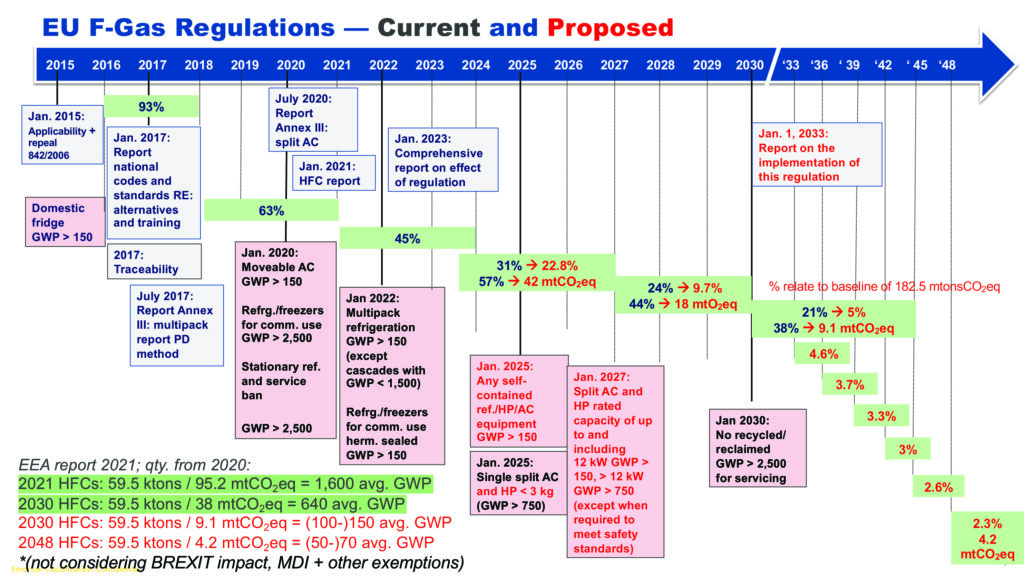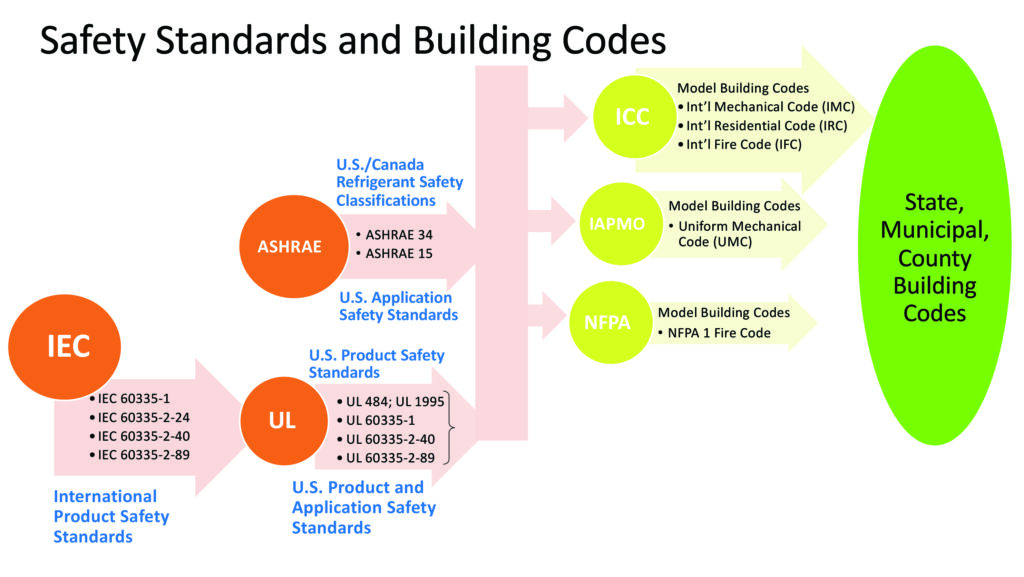Introduction
In 2016, the Kigali Amendment to the Montreal Protocol treaty recognized the effect that high global warming potential (GWP) hydrofluorocarbon (HFC) refrigerants have on the environment, and hastened a shift to lower-GWP refrigerants. This transition from legacy HFCs to emerging low-GWP refrigerants is causing component- and system-level architecture changes in both comfort cooling/heating and commercial refrigeration applications (HVACR industry). When large-scale changes in system architecture such as this occur, they also introduce changes to design, installation, the commissioning process and maintenance practices of these equipment. This in turn leads to a requirement for retraining of the HVACR technician workforce. Although the shift from high-GWP HFCs to low-GWP alternatives yields many environmental benefits, it also presents new challenges and opportunities.
Refrigerant-specific impacts on equipment design
New refrigerant alternatives — including natural and/or synthetic options — have less direct impact on the environment due to their lower-GWP ratings. This is by far the most important benefit that the next generation of refrigerants can provide. A challenge that original equipment manufacturers (OEMs) and end users face is answering a key question about equipment longevity: How low does the GWP have to be to support the equipment throughout the full lifecycle? Keep in mind that for end users, they hope to keep their equipment operational from ten to twenty or even thirty years — such is the typical lifespan of HVACR equipment.

Figure 1 demonstrates how the HFC phase-down in Europe (shown as an example) will result in rapidly changing regional and local regulations in a relatively few years. For OEMs, this will introduce significant challenges, especially to avoid the potential for stranding any equipment in mid-design cycle.
Additionally, the design of the HVACR system must account for several refrigerant-specific factors and characteristics, such as:
- CO2 (or R-744) has high pressures
- Propane (or the A3 R-290) has a higher flammability rating
- Synthetic A2L refrigerants (such as R-32) have a lower flammability rating and a degree of glide
The higher pressure and flammability factors have already reshaped equipment design strategies, requiring higher strength to handle pressures and less (or near-zero) leaks for flammable refrigerants. Leak detection and sensing technologies and associated control systems for safety management and risk mitigation are examples of new system requirements.
OEMs also need to understand equipment energy consumption (both on an annual basis and peak load conditions), system first cost, long-term cost of maintenance, and the effects of refrigerant glide, especially in reversible systems like heat pumps.
Even with these new requirements and challenges, it is possible for the HVACR industry to overcome them and phase down the use of HFCs at a measured pace. Doing so will require stakeholders to use all available tools in the refrigeration toolbox.
Enabling tools, technologies and design strategies
While there are many tools available, some are more effective than others in their abilities to address emerging design challenges.

Transitioning to low-GWP refrigerants, especially those that are flammable, has led to a strategy of minimizing the refrigeration (or heating) load to the lowest possible value. Load reduction reduces the size of the system, and therefore the amount of refrigerant charge needed. At the same time, this low-load strategy has the added benefit of reducing the power and energy consumption, therefore contributing to lower greenhouse gas (GHG) emissions.
When refrigeration systems require a precise quantity of refrigerant (aka critically charged), their leak-tightness becomes even more important. Even small leaks must be detected and risk mitigation measures taken to manage safety (see safety standards and codes section).
The associated benefits of load reduction are also applicable for existing systems. Thus, proper retrofitting of existing systems or the installed base offers another opportunity to improve performance and achieve environmental objectives. For example, simply adding doors to refrigerated display cases can reduce loads, power and energy by as much as two-thirds3. In a comfort cooling or heating system, this could be something as fundamental as adding insulation to the building envelope (walls or attic).
As the HFC phase-down proceeds and supplies decrease, we can expect it to become more difficult to service of existing and/or legacy HFC-based equipment. Thus, retrofitting to a lower-GWP replacement refrigerant is recommended whenever possible — in addition to making sure that the legacy equipment is maintained well and leak tight. While it is not permitted to retrofit a system currently charged with a non-flammable HFC refrigerant to a low-GWP flammable refrigerant replacement, one can usually find lower-GWP candidates of the same flammability class. Reclaiming and reusing legacy HFC refrigerants will also become a mandatory step as the regulatory phase-down and the rising price of refrigerants make it cost-prohibitive — and environmentally harmful — to vent HFC refrigerants into the atmosphere.
A2L safety standards and building codes
As previously mentioned, many of the low-GWP refrigerants to which the HVACR industry is transitioning are classified as A2L with a “lower flammability” rating. Because this A2L classification is relatively new, some safety standards are still in the process of being completed especially in commercial refrigeration. Figure 3 lists the major applicable global safety standards, including IEC, ASHRAE and UL.

In many parts of the world, the standards are yet to be adopted into the state, regional or national codes or legal frameworks. Trade practitioners — such as engineers and technicians and inspectors — must familiarize themselves with a completely new approach to handling and using these flammable refrigerants. There are many resources that are being developed by AHRI4 and ASHRAE/UNEP5 to facilitate this education process.
Embedded within these new safety standards are requirements for leak detection, risk mitigation and safety management techniques — all of which will be more important than most people realize in enabling the use of flammable refrigerants in these systems. Leak detection and repairs aimed at safety also serve the purpose of preventing loss to the atmosphere and the negative direct global warming impact. Although detecting small quantities of refrigerant leak can be a challenge, many leak sensor and risk mitigation technologies are emerging in the commercial market well in advance of the low-GWP transition deadlines in the United States. It’s interesting to note that equipment owners are already evaluating and deploying these leak detection devices for their existing asset bank of high-GWP A1 HFC refrigerants — an early and unexpected side benefit of the transition to flammable refrigerants.
Prioritizing energy efficiency
Although the direct global warming impact from refrigerant leaks is often at the center of environmental attention, the indirect impacts from the energy used by the equipment itself is nearly fifty times greater6.

As figure 4 reveals, the demand for power in California is highest in the evening hours, and during the middle of the day, demand slows down considerably. Typically, “peaker” fossil fuel plants must be brought into operation to compensate for this evening shortfall. As regulatory focus shifts to GHG emissions reductions, renewable sources of power like solar and wind are growing in value and importance. All of this will only lead to the effect of the “duck curve” being exaggerated as renewables like solar generate most of their energy during the middle of the day.
This energy consumption pattern is important to consider within the context of low-GWP refrigerant transition: It can only succeed if the energy and the peak power do not further add to the resiliency issues that the electric grids already face throughout much of the world. Varying degrees of this duck curve phenomenon exist in all regions of the world; they will need to be understood and addressed to prevent brownouts and blackouts.
Thus, the energy efficiency of the new generation of low-GWP refrigerants is a key part of the transition — which is also recognized as vital to the success of the HFC phase-down. Designing a system for minimum refrigeration load is the first step in this process. Minimizing load through design strategies (i.e., insulation, doors, heat recovery, etc.) needs to be followed by proper selection of equipment with a holistic focus on entire system performance — not just the individual components). In addition, installation best practices, proper commissioning and most importantly ongoing maintenance throughout the equipment lifecycle will be key to achieving required system energy efficiencies.
Conclusion: necessity drives innovation
The environmental benefits from the HFC phase down does not come without its cost and challenges. Yet, these challenges, when met and overcome, can potentially lead to great opportunities for the HVACR industry while bringing the benefits of comfort cooling and heating, hot and sanitized water, refrigerated food and pharmaceuticals to all regions of the world. The continued growth and evolution of refrigeration and cooling must be realized in a sustainable manner, beyond merely transitioning to low-GWP refrigerants. Over the course of the next decades, we will see innovations in the use of CO2, hydrocarbons, and even water and air as the refrigerant — not to mention the various other so called “not in kind” or non-vapor compression technologies. As an industry, we are at the beginning of a new phase of inventions that will make the past hundred years seem ordinary!

Rajan Rajendran
References
- Private communication: Ms. Dina Koepke, Emerson Climate Technologies.
- AHRI Webinar: How to Not Only Survive, but “Win” the Refrigeration Industry HFC Phasedown. https://youtu.be/mSWF6qaSoWE
- https://www.energy.gov/sites/prod/files/2013/12/f5/commlbldgs18_goetzler_040413.pdf
- https://www.ahrinet.org/saferefrigerant
- https://www.ashrae.org/professional-development/ashrae-unep-portal
- Hung M. Pham and Rajan Rajendran. “R32 and HFOs as Low-GWP Refrigerants for Air-Conditioning”, International Refrigeration and Air Conditioning Conference, Purdue University, 2012.
- https://www.energy.gov/eere/articles/confronting-duck-curve-how-address-over-generation-solar-energy
